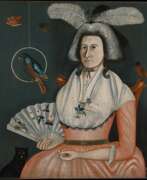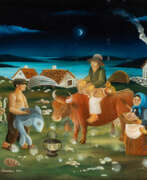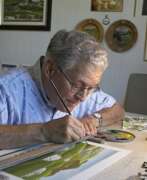Genre art Folk Art


Lado Gudiashvili (Russian: Ладо Давидович Гудиашвили) was a Georgian artist, celebrated for his distinctive and innovative contributions to 20th-century art. Born in Tbilisi, Gudiashvili embarked on his artistic journey at the Tbilisi school of sculpture and fine art, later enhancing his skills in Paris's Ronson's private academy. His work, deeply influenced by Georgian life and culture, masterfully blends dramatic grotesque with poetic mystery, often incorporating elements of Caucasian and Persian traditions.
Gudiashvili's artistic repertoire was vast, encompassing painting, book design, graphic art, and teaching. He was an integral part of the Tbilisi Modernism and Socialist Realism periods, contributing significantly over a 60-year career. His engagement with avant-garde circles in Tbilisi and his murals for popular cafes showcased his versatility and creativity. Gudiashvili's Paris years (1919-1926) were marked by independence and recognition, as he exhibited alongside notable contemporaries and was encouraged to showcase his work independently.
His contributions were not limited to canvas; Gudiashvili also left an indelible mark on set design and book illustration, working on productions and literary classics that remain influential. Notably, his works adorn the Kashveti Church in Tbilisi, a testament to his monumental talent. Despite facing challenges, including political pushback for his church paintings, Gudiashvili's legacy as a pioneering Georgian artist remains undisputed. He received several high Soviet honors, underscoring his significance in the art world.
For collectors and experts in art and antiques, Gudiashvili represents a vital link between Georgian cultural heritage and modernist expressions. His works, which include engaging illustrations, set designs, and captivating paintings, continue to attract interest for their historical significance and artistic value.
To stay updated on sales and auction events featuring Gudiashvili's works, sign up for updates. This subscription will ensure you're informed about opportunities to acquire pieces by this remarkable Georgian artist.


William Henry Johnson was a twentieth-century American artist. He is known as a primitivist painter.
William Johnson began his artistic career with realism, but then turned to primitivism and expressionism. He became famous for his works in the folk African-American style.
Johnson was an activist in the Harlem Renaissance cultural movement led by leading African American writers and artists.


Anatoly Galaktionovich Petritsky (Russian: Анатолий Галактионович Петрицкий), a prominent Ukrainian and Soviet painter, graphic artist, theater artist, and teacher, was a master of the Ukrainian avant-garde who lived from 1895 to 1964. Born in Kiev, Petritsky was an influential figure in the Ukrainian art scene during the first half and mid-20th century. Despite the tragic loss of a large number of his graphic and pictorial works in a fire, his impact on the art world remains significant.
Petritsky's early career was marked by a vibrant engagement with the avant-garde movement. He studied at the Kiev Art School and later at the Moscow VKHUTEMAS, a hub for avant-garde art, under the guidance of A.D. Drevin and N.A. Udaltsova. His work from this period, including the painting "Invalids," exhibited at the 17th Venice Biennale in 1930, showcased his engagement with abstract paintings and constructive reliefs, highlighting the atrocities of war and reflecting on his dark childhood experiences.
Throughout the late 1920s and early 1930s, Petritsky's work diversified into painting, graphics, set design, illustration, and poster art, strongly influenced by Russian avant-garde styles. He created over 100-150 portraits, capturing not just the facial features but the essence and character of his subjects, including notable figures of the time.
Petritsky was awarded the title of People's Artist of the USSR in 1944 and won the Stalin Prize of the USSR twice, in 1949 and 1951, for his set designs. He taught at the Kiev Art Institute from 1946 to 1950, where he was a professor starting from 1947. His contributions to the art world are preserved in his memoirs, published in 1981, offering insights into his creative process and the artistic landscape of his time.
For collectors, experts in art, and antiques, the work and life of Anatoly Galaktionovich Petritsky offer a profound glimpse into the evolution of Soviet and Ukrainian avant-garde art. His legacy continues to inspire and influence contemporary art movements.
To stay updated on new discoveries, exhibitions, and auctions related to Anatoly Galaktionovich Petritsky's work, consider signing up for updates. This subscription will keep you informed about new product sales and auction events related to this key figure in the Ukrainian art of the 20th century.


Diego María de la Concepción Juan Nepomuceno Estanislao de la Rivera y Barrientos Acosta y Rodríguez, more commonly known as Diego Rivera, was a prominent Mexican painter celebrated for his critical role in establishing the Mexican mural movement both nationally and internationally. Born on December 8, 1886, in Guanajuato, Mexico, to a well-to-do family, Rivera was a child prodigy in art, encouraged by his parents from a young age after they noticed his penchant for drawing. This early support included installing chalkboards and canvases on the walls of their home to foster his talent.
Rivera's art was not just limited to murals; he was also a key figure in Mexican Cubism and had a rich body of easel paintings. However, his murals, depicting scenes of Mexican society and reflecting his leftist political views, remain his most notable contributions. Some of his most famous works include "Man at the Crossroads," which stirred controversy due to its inclusion of Lenin, leading to its destruction at the Rockefeller Center in New York. Rivera's murals are scattered across Mexico and the United States, serving as historical documents that highlight his technical skill and deep social engagement.
His personal life was as colorful and tumultuous as his art, marked by multiple marriages, including to fellow artist Frida Kahlo. Their relationship was both passionate and stormy, significantly influencing their respective works. Rivera's legacy extends beyond his artwork; he was a mentor to several artists and left an indelible mark on the art world with his contributions to public art and his political activism. His works have been declared national monuments by the Mexican government, underscoring his pivotal role in the country's cultural heritage.
For collectors and experts in art and antiques, Rivera's works offer not only aesthetic beauty but also deep social and historical insights. If you're passionate about adding a piece of this rich cultural heritage to your collection or staying updated on auction events related to Diego Rivera's art, signing up for updates can provide you with timely information on new sales and exhibitions featuring his masterpieces.


Tommy Wayne Cannon, also known as T. C. Cannon, was a 20th century American Indian artist.
In his work, T. C. Cannon often addressed themes of Native American identity, culture, and the impact of colonisation. He conveyed powerful messages of social and political significance in his paintings and prints.
Cannon's works are characterised by vivid colours, bold compositions and profound storytelling, leaving an indelible mark on the art world.


William Traylor was an African-American self-taught artist from Lowndes County, Alabama. Born into slavery, Traylor spent the majority of his life after emancipation as a sharecropper. It was only after 1939, following his move to Montgomery, Alabama, that Traylor began to draw. At the age of 85, he took up a pencil and a scrap of cardboard to document his recollections and observations. From 1939 to 1942, while working on the sidewalks of Montgomery, he produced nearly 1 500 pieces of art.
While Traylor received his first public exhibition in 1940, it was not until 30 years after his death that his work finally began to receive broader attention, in the late 1970s. Recent acceptance of Traylor as a significant figure of American folk and modern art has been founded on the efforts of Charles Shannon, as well as the evolving tastes of the art world. Shannon, who first encountered Traylor's work in 1940, brought Traylor to the attention of the larger art world. Traylor now holds a central position in the fields of "self-taught" and modern art.





























































